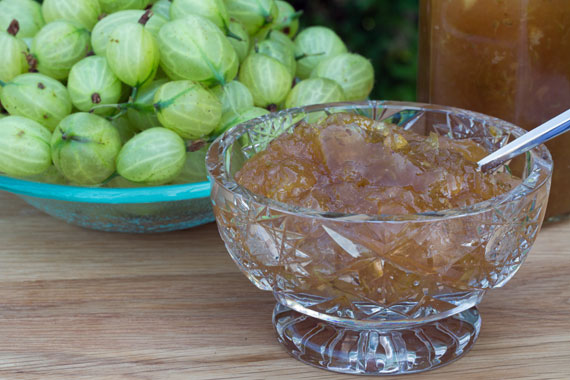Gooseberries are indigenous to northern Europe and thrive in Sweden’s cool climate with damp soil and so have long been popular in Sweden. However, strangely they are not sold that often in supermarkets in Sweden and so Swedes who like gooseberries often have to grown their own.
Gooseberries, with their slightly tart flavour, make make a refreshing change from other summer fruits. They are also rich in vitamins A, B and C so they are good for you too.
Gooseberries are enjoying something of a revival and beginning to make more appearances in supermarkets. If you see any, buy some and make this delicious compote!
Summary
Makes about 4×1 lb jars
Preparation: 10 minutes
Cooking: 40 minutes
Total: 50 minutes plus time to cool
Tips
– I prefer to make this compote with a tart cooking gooseberry such as Invicta, Jubilee or Careless. If you choose a sweeter variety, such as Xenia, you might need to reduce the amount of sugar.
– I prefer a slightly tart compote, so I have suggested using 800g of sugar per 1000g of gooseberries, rather than equal weights of sugar and berries which is more usual. Do feel free to increase the amount of sugar if you have a sweet tooth.
– I use homemade elderflower cordial (syrup), but if you haven't got any you can use a good quality commercial brand instead.
– Where I live, by the time gooseberries are ready the elderflower season is over, but for a recipe using fresh elderflowers scroll down.
– The compote is delicious on scones, crumpets and muffins, with våfflor (waffles) or pannkakor (pancakes) or in a flaky pastry layer cake.
– The compote can also be heated gently and served as a sauce with pork or poured over ice cream.
– Don't boil for more than seven minutes in step four without doing a “saucer test”, otherwise the compote may end up overcooked.
– For more tips on jam making, click here.
Ingredients
1 kg (2 ¼ lb) green gooseberries
800g (4 cups) jam sugar (there is enough pectin in gooseberries to use ordinary granulated sugar if you prefer a lighter set)
6 tbsp elderflower cordial (syrup)
½ tsp butter, if necessary
½-1 tsp elderflower essence, if necessary
Method
1. Pick over the gooseberries, removing any bruised berries or leaves. Rinse and then top and tail.
2. Add about two millimetres (1/8 inches) of water to a preserving pan. Tip the washed gooseberries into the pan and add the elderflower cordial (syrup). Gently bring to a simmer, stirring regularly to ensure that the berries don't burn. Simmer gently until the berries are soft, about ten minutes.
3. Add the sugar, stir well and heat gently again, stirring until all the sugar is dissolved, about ten minutes.
4. Increase the heat to maximum and boil rapidly for between four minutes (light set) to seven minutes (firm set). Stir occasionally to avoid burning.
5. Use a slotted spoon to carefully remove the scum. If any scum is hard to remove, add a little butter and stir it into the mixture as this will help to dissolve the remaining scum.
6. Leave the compote to cool for 15 minutes, then have a taste. If you think it needs a litte more elderflower, add some essence, stirring thoroughly after each addition.
7. Finally, pour into sterilized jars and seal.
Using fresh elderflowers
If you live in an area where elderflowers and gooseberries are ripe together then you can use the method below.
Ingredients
1 kg (2 ¼ lb) green gooseberries
800g jam sugar (or ordinary granulated sugar, see above)
10-12 elderflower heads
½ tsp butter, if necessary
Method
1. Pick over the elderflowers carefully to ensure that there are no insects lurking in their midst (if necessary, leave them to soak for a few minutes in water). Tie them together with a long piece of string, leaving at least 30 centimetres free.
2. Pick over the gooseberries, removing any bruised berries or leaves. Rinse and then top and tail.
3. Add about two millimetres of water to a preserving pan. Tip the washed gooseberries into the pan and slowly bring to the boil, stirring regularly to ensure that they don't burn. Boil steadily until the berries burst.
4. Add the sugar and elderflowers, leaving the string hanging over the edge of the pan so that you can fish them out later. Stir well and heat gently again, stirring until all the sugar is dissolved, about ten minutes.
5. Increase the heat to a maximum and boil rapidly for between four minutes (light set) and seven minutes (firm set), stirring occasionally to avoid burning the bottom of the pan.
6. Remove the elderflowers and discard them, then use a spoon to remove the scum.
7. If any scum is hard to remove, add a little butter and stir it into the mixture as this will help to dissolve the remaining scum.
8. Leave to cool for 15 minutes, then give one final stir, pour into sterilized jars and seal.
Recipe published courtesy of John Duxbury, founder and editor of Swedish Food.



 Please whitelist us to continue reading.
Please whitelist us to continue reading.